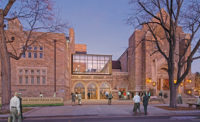"It only took about an hour of walking around the hospital and observing and talking to patients who had just come through an incredibly traumatic experience trying to learn how to function for us to realize what an absolutely special international facility this is," Thorne says. "I became so attached to this project. We don't look at it as a hospital; it's really more like a university—a school for teaching people how to lead their lives."
GE Johnson's liaison acts as the conduit between Craig staff, the patients and the construction team to coordinate where noise will be happening each day, where materials will come in and how the building can be accessed. Project staff walk each nursing unit regularly, and the contractor publishes a weekly noise forecast. Monthly lunch meetings give hospital staff updates on the construction, and a website shares milestones and details about what's ahead.
Disruptive construction activities also are shut down for an hour or two every day. Hammering, drilling and other noises are stopped to give patients some rest time. Sometimes it happens on a moment's notice, and despite fears that carving a few minutes a day out of the schedule could delay the project, "amazingly, it hasn't," Means says. "GE Johnson has made it work."
Five Phases
The project was broken into five phases. During Phase 1, which finished in August, the four-story tower addition was constructed on the north of the existing west building. The core-and-shell of the fourth floor extends over the west building, taking it from three stories to four. GE Johnson delayed finish work to avoid disturbing patients on the third floor.
Phase 2 entailed a complete build-out of the fourth floor shell area, plus demolition and asbestos abatement on the newly vacated third floor. Elevators and stairwells were extended to the fourth floor. Elevators were shut down and disconnected from cables. The existing slab was demolished, a new machine room slab was created and the elevators were hooked up to new machinery in a time-consuming, tricky process, Skidmore says.
Phase 2 neared completion in mid-February, and second-floor patients soon will be relocated for build-out of the third floor. Work will continue, floor by floor, vacating each floor below as the previous phase ends to provide a layer of sound protection.
"The entire schedule and how we phased it posed challenges from start to finish," Skidmore says. The construction team hasn't been able to use nights and weekends to make up lost time that occurs during the day, so coordination—and flexibility—is key.
GE Johnson and its subcontractors "are sensitive to the wonder that's occurring [inside Craig], working around schedules, coming up with acoustic barriers that have never been used before, phasing the project to allow for an empty floor between any work and the traumatic brain-injury patients. "There has been an absolute coordination and communication with the staff about anything that might create noise or an outage," Thorne says.
Phases 3 through 5 will start in the first half of 2015, with final completion in August 2016. "The renovated portions will be like a new building when the project is done, with just a few mechanical rooms, basement space, offices and engineering left untouched. Everything else was gutted and replaced," Skidmore says.
Early in the project, Craig and the project team championed a key project milestone: working with the city of Englewood to permanently close the 3400 block of Clarkson Street to through traffic. Clarkson had always split Craig West from Craig East, and patients and their families had to cross it to get from one part of the hospital to the other. Now it's being incorporated into the hospital campus, redesigned with sidewalks and landscaping and shady spots for families to sit outside and enjoy the sunshine.
"This [entire project] is an example of collaboration worthy of emulation," Means says. "For people to leave Craig feeling good about the process and glad they came here for these services—when the building was under construction during their entire stay—that was our goal. We were able to maintain a high level of rehab services throughout the project. No patient has gone without any service offered—we found a way to provide it."









Post a comment to this article
Report Abusive Comment